General information about the 1-1-2-1 press defense
Basic definition
The 1-1-2-1 press defense is a basketball strategy that emphasizes defensive pressure as well as traps near the corners, ultimately to create turnovers or at minimum, to disrupt offensive scoring opportunities near the basket or near perimeter areas of the court.
1-1-2-1 press defense: Initial formation example
The diagram below showcases an example of the initial formation for the 1-1-2-1 press defense.
Also, in reference to the diagram below and additional diagrams in later sections, each defensive player is indicated by the letter X shown alongside a number that is subscript.
For the purposes of this web page, this letter X and the adjacent subscript number symbolizes one of the standard basketball positions.
This also applies to offensive players but without the letter X. Instead, offensive players will simply be referred to as their respective number.
In essence, the defensive and offensive point guards are denoted as X1 and 1, respectively. The defensive and offensive shooting guards are indicated as X2 and 2, respectively.
The defensive and offensive small forwards are represented as X3 and 3, respectively. The defensive and offensive power forwards are signified as X4 and 4, respectively.
Lastly, the defensive and offensive centers are denoted as X5 and 5, respectively.
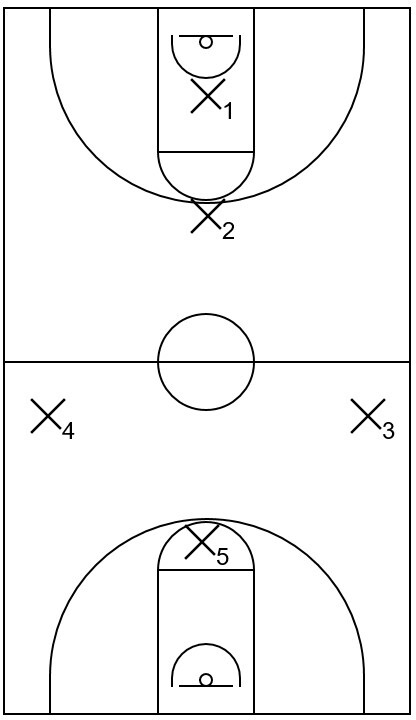
As it relates to the initial setup, X1 starts in the offensive team’s backcourt within the lane between the basket and the free throw line.
X2 also begins in the offensive team’s backcourt as well, but at the top of the three-point arc.
X3 and X4 start in the offensive team’s frontcourt near the half court line and sidelines.
In addition, X5 begins in the frontcourt but near the high post, also known as the nail area.
General meaning behind the 1-1-2-1 numbering format
Essentially, it is called 1-1-2-1 because each digit represents the general alignment for the defensive players on the court.
To provide more clarity of this concept, the digits between dashes represent the number of defensive players that will be located in a certain region of the court, usually from the front, the middle, or the back.
Also, more dashes in a numbering format generally means more regions for the players to occupy on the court.
Basically, one dash would generally represent two regions of the court that players would fill.
An example of that would be the 2-3 zone defense, which contains two players in the front region and three players in the back region.
Furthermore, two dashes would typically signify three regions for players to occupy on the court.
An example of that would be the 1-3-1 zone defense, which contains one player in the front region, three players in the middle region, and one additional player in the back region.
In a similar fashion, three dashes would usually be indicative of four regions that players would fill on the court.
An example of that would be this particular press itself. In other words, for this 1-1-2-1 press defense, the players will align in four regions on the court from the front to the back.
The diagram below gives a demonstration of this concept.
1-1-2-1 press example: Initial formation with regions
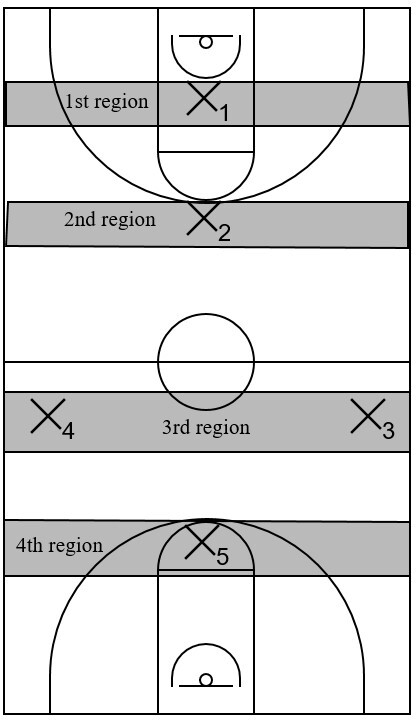
This is an example diagram of the 1-1-2-1 press during the initial formation and it contains one or more defensive players within different regions on the court.
In essence, the first region contains one player, who is X1 for this example. The second region contains another player, who is X2 for this example.
The third region contains two players, who are X3 and X4 for this example. Finally the fourth contains yet another player, who is X5 for this example.
Primary defensive actions within the 1-1-2-1 press
Pressure offensive player in possession of ball towards sideline
A defender in the first region of the press should apply a certain amount of pressure that influences the offensive player in possession of the basketball to dribble it towards the sideline.
Also, in some instances, a defender in the second region of the press could implement pressure to nudge an offensive player in possession of the ball towards a sideline.
The defender within the second region will typically apply pressure when an offensive player in possession of the ball reverses it via a backcourt backwards pass or by way of a backcourt skip pass.
Protect the middle area of the court
A defender should always be available to protect the middle area of the court, particularly when an offensive player is being pressured towards a sideline or when an offensive player is being trapped in a corner.
Generally speaking, players within the first, second, and third region will protect the middle of the court depending on the location of the ball as well as the defensive actions of other team members.
Set traps near corners
Two defenders should typically trap the basketball when it is in the frontcourt corner near the half court line.
Additionally, it should be noted that this particular area could be referred to as a coffin corner as well.
Essentially, once an offensive player gets trapped in that area of the court, it would be difficult for them to release the defensive pressure, mainly via action such as ball reversal or an escape dribble.
Furthermore, defensive players could also set traps when an offensive player has possession of the ball in the frontcourt corner near the baseline and adjacent sideline.
Generally speaking, defenders of all regions could have an opportunity to set a trap with a teammate.
Protect the basket
A defender should drop back into the lane area to protect the basket, generally when an offensive player has control of the ball in the frontcourt or when an offensive player with or without possession of the ball moves below the free throw line extended area.
The defender within the fourth region will usually be the initial basket protector. However, defenders within the third region could also drop back to protect the basket in certain instances.
Examples of 1-1-2-1 press defensive rotations
Example 1: Initial defensive pressure in the backcourt
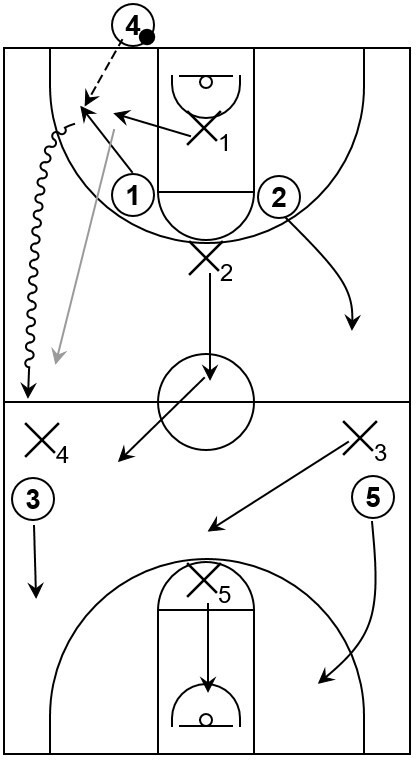
At the beginning, 1 receives the ball via an inbound pass from 4.
As that happens, X1 immediately applies defensive pressure and executes a proper defensive slide to influence 1 towards the adjacent sideline.
From there, 1 begins dribbling down the court near the sideline, represented by the arrow with a wavy line while X1 mirrors that path, indicated by the gray arrow towards the half court line.
Additionally, as those actions transpire, X2 initially drops back to protect the middle area in the backcourt while X3 protects the middle in the frontcourt.
Moreover, as 5 cuts below the free throw line extended, X5 drops back to protect the basket.
Also, as 1 begins to dribble or pass into the frontcourt area, X2 slides toward the extended slot area in the frontcourt, mainly to be a hindrance if 1 attempts to pass the ball to the adjacent frontcourt wing area.
Example 2: First potential trap
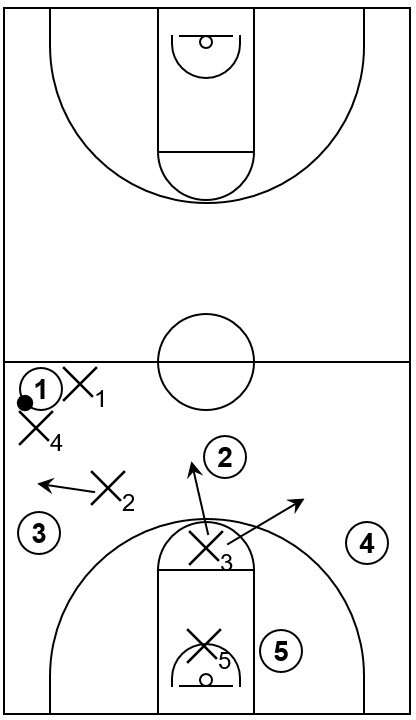
This is an example of the first potential trap that could occur in the offensive team’s frontcourt corner adjacent to the half court line.
Essentially, if X1 successfully influences 1 into dribbling down the nearest sideline, then X4 could set a trap in the corner with X1 once 1 crosses the half court line.
What’s more, X2 could continue to hinder a possible passing option for 1 by playing denial defense against 3 near the wing area.
In other words, X2 could place a hand in the passing lane between 1 and 3, represented by the arrow, ultimately to increase the difficulty of 3 receiving an easy pass from 1.
In addition to that, X3, who is currently near the high post, could potentially intercept passes thrown to either 2 or 4 near the top or opposite wing respectively.
X5 continues to protect the basket, similar to the previous diagram.
It should be mentioned as well that for these examples, a defensive three-second rule is not in play, which allows X5 or other defenders to stay in the lane on an indefinite basis.
Example 3: Defensive actions after pass to corner
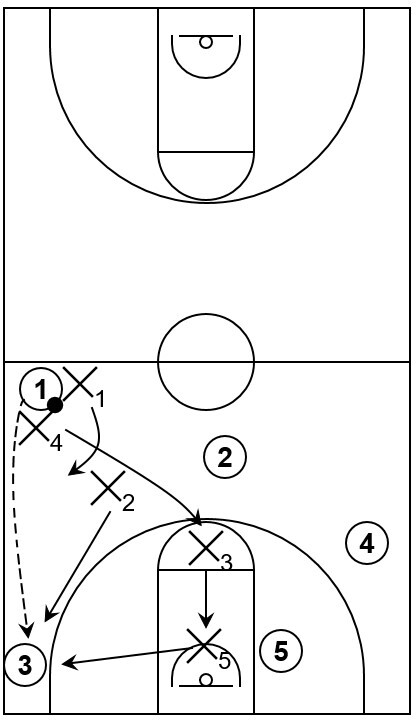
This is an example scenario that shows the defensive actions that could happen if the offensive player in possession of the ball is able to pass out of the first potential trap towards the baseline corner.
Basically, on the diagram, 3 receives the ball from 1 in the corner, represented by the dotted arrow. This would also be on the right side of the frontcourt from the offensive team’s point of view.
When that happens, X5 and X2 have to sprint to closeout on the ball.
At the same time, X3 has to drop back into the lane to replace X5 as the current rim protector.
Furthermore, X4 has to replace the vacant spot left by X3 at the high post area and X1 can slide down slightly towards the ball. X1 does that to stand in the space between 1 and 3 for the time being.
Example 4: Second potential trap
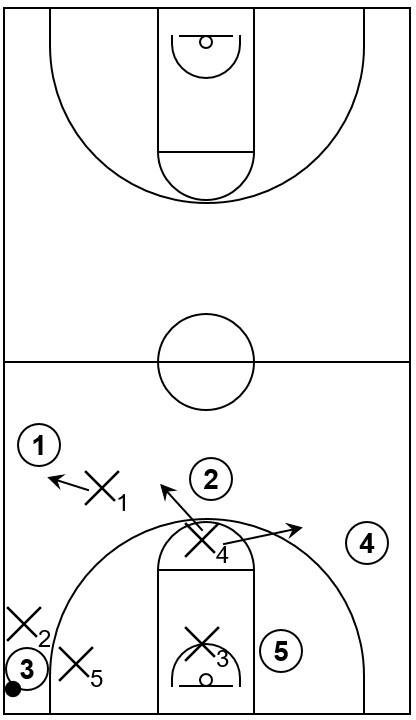
This is an example of the second potential trap that could occur in the offensive team’s frontcourt corner near the baseline.
In essence, after 3 receives the ball from 1 as shown on the previous diagram, X2 and X5 can set a trap near the baseline corner.
Also, as that happens, X1 can implement denial defense by placing a hand in the passing lane between 1 and 3, represented by the arrow.
From there, if 3 were to attempt to pass the ball back to 1, then X1 could potentially deflect the ball or possibly intercept it, which could lead to transition offense as well.
Moreover, X4 could potentially intercept passes that would be received by 2 or 4, represented by the arrows. Additionally, X3 continues to protect the basket.
Example 5: Defensive actions after reversal in the backcourt
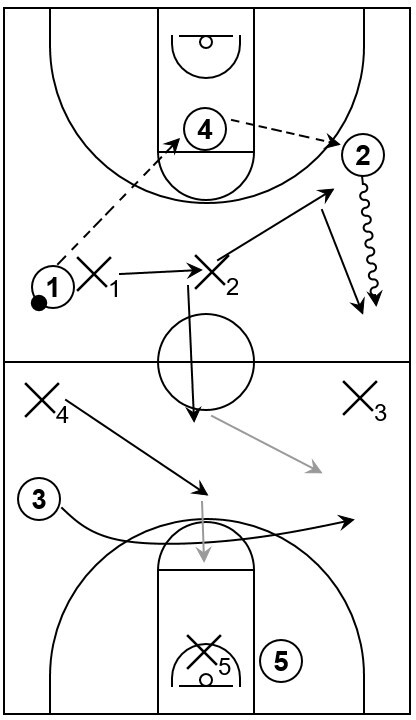
This is an example of defensive actions that could occur when the offensive player in possession of the basketball reverses it via a backwards pass while still in the backcourt, prior to the first potential trap.
On the diagram, 4, who executed the initial inbound pass, has stepped onto the court from out of bounds and receives the ball from 1 before the defense is able to set the first potential trap.
Once that happens, X1 and X2 briefly wait to see if 4 will pass to another teammate or dribble down the court.
In this instance, 4 decides to pass the ball with 2 as the recipient.
Therefore, X2 immediately begins to sprint towards 2 while also attempting to force 2 towards the adjacent sideline.
At the same time, X1 slides over to protect the middle area in the offensive team’s backcourt while X4 does the same but in the frontcourt.
X3 stays in position ready to set the first possible trap, this time on the opposite side of the court.
Meanwhile, X5 has dropped back into the lane, ready to protect the basket, mainly as a safety option against 5, who has moved below the free throw line extended area as well.
What’s more, if 3 runs across the court as a possible frontcourt passing option for 2, then X1 should continue down the middle area before eventually sliding towards the strong side wing area to deny an easy pass towards 3, denoted by the gray arrow.
In addition, X4 can continue to slide back towards the high post area, indicated by the gray arrow.